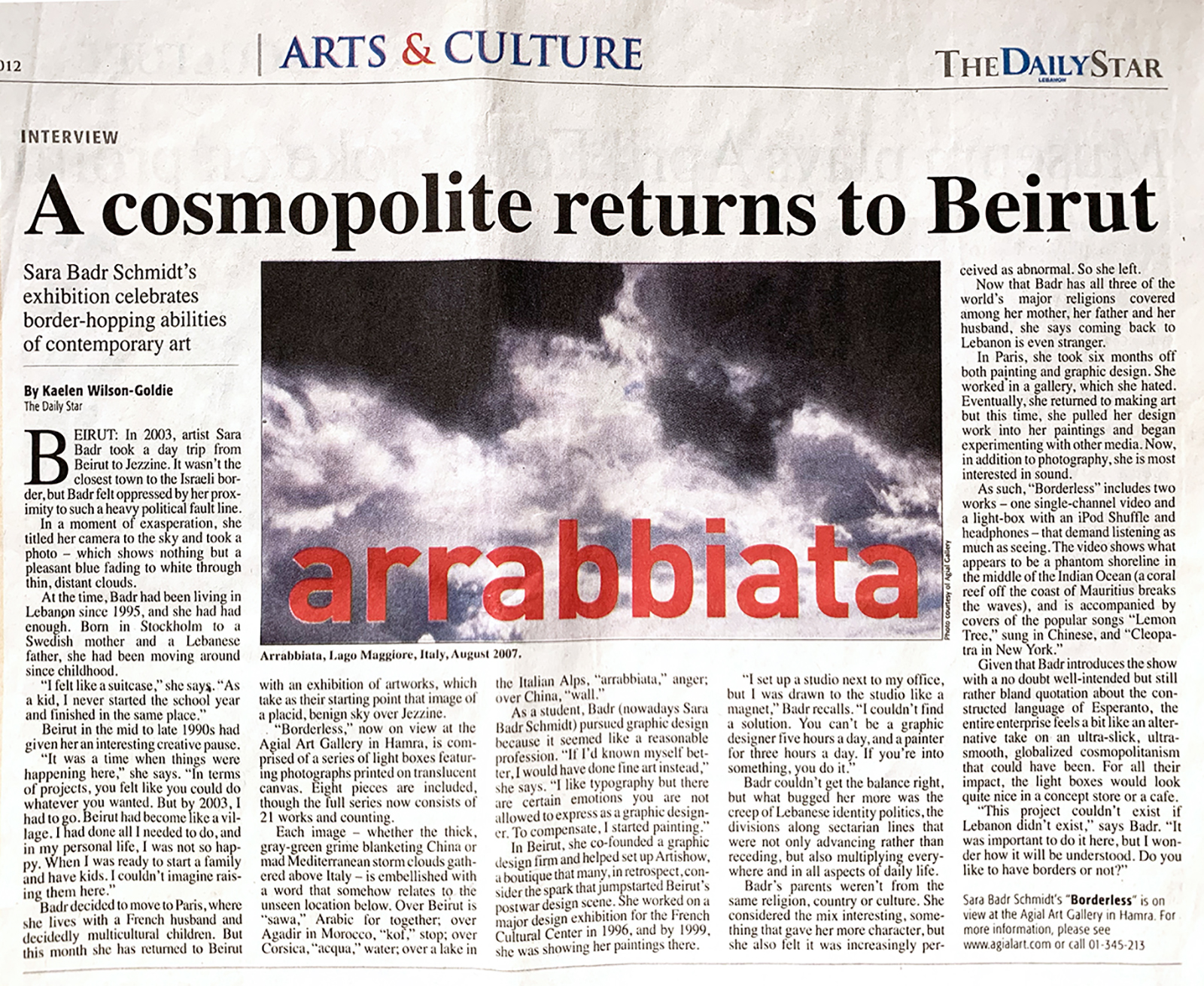A cosmopolite returns to Beirut
Beirut, March 31, 2012
by Kaelen Wilson-Goldie
Beirut: In 2003, artist Sara Badr took a day trip from Beirut to Jezzine. It wasn’t the closest town to the Israeli border, but Badr felt oppressed by her proximity to such a heavy political fault line.
In a moment of exasperation, she titled her camera to the sky and took a photo – which shows nothing but a pleasant blue fading to white through thin, distant clouds.
At the time, Badr had been living in Lebanon since 1995, and she had had enough. Born in Stockholm to a Swedish mother and a Lebanese father, she had been moving around since childhood.
“I felt like a suitcase,” she says. “As a kid, I never started the school year and finished in the same place.”
Beirut in the mid to late 1990s had given her an interesting creative pause.
“It was a time when things were happening here,” she says. “In terms of projects, you felt like you could do whatever you wanted. But by 2003, I had to go. Beirut had become like a village. I had done all I needed to do, and in my personal life, I was not so happy. When I was ready to start a family and have kids. I couldn’t imagine raising them here.”
Badr decided to move to Paris, where she lives with a French husband and decidedly multicultural children. But this month she has returned to Beirut with an exhibition of artworks, which take as their starting point that image of a placid, benign sky over Jezzine.
“Borderless,” now on view at the Agial Art Gallery in Hamra, is comprised of a series of light boxes featuring photographs printed on translucent canvas. Eight pieces are included, though the full series now consists of 21 works and counting.
Each image – whether the thick, gray-green grime blanketing China or mad Mediterranean storm clouds gathered above Italy – is embellished with a word that somehow relates to the unseen location below. Over Beirut is “sawa,” Arabic for together; over Agadir in Morocco, “kof,” stop; over Corsica, “acqua,” water; over a lake in the Italian Alps, “arrabbiata,” anger; over China, “wall.”
As a student, Badr (nowadays Sara Badr Schmidt) pursued graphic design because it seemed like a reasonable profession. “If I’d known myself better, I would have done fine art instead,” she says. “I like typography but there are certain emotions you are not allowed to express as a graphic designer. To compensate, I started painting.”
In Beirut, she co-founded a graphic design firm and helped set up Artishow, a boutique that many, in retrospect, consider the spark that jumpstarted Beirut’s postwar design scene. She worked on a major design exhibition for the French Cultural Center in 1996, and by 1999, she was showing her paintings there.
“I set up a studio next to my office, but I was drawn to the studio like a magnet,” Badr recalls. “I couldn’t find a solution. You can’t be a graphic designer five hours a day, and a painter for three hours a day. If you’re into something, you do it.”
Badr couldn’t get the balance right, but what bugged her more was the creep of Lebanese identity politics, the divisions along sectarian lines that were not only advancing rather than receding, but also multiplying everywhere and in all aspects of daily life.
Badr’s parents weren’t from the same religion, country or culture. She considered the mix interesting, something that gave her more character, but she also felt it was increasingly perceived as abnormal. So she left.
Now that Badr has all three of the world’s major religions covered among her mother, her father and her husband, she says coming back to Lebanon is even stranger.
In Paris, she took six months off both painting and graphic design. She worked in a gallery, which she hated. Eventually, she returned to making art but this time, she pulled her design work into her paintings and began experimenting with other media. Now, in addition to photography, she is most interested in sound.
As such, “Borderless” includes two works – one single-channel video and a light-box with an iPod Shuffle and headphones – that demand listening as much as seeing. The video shows what appears to be a phantom shoreline in the middle of the Indian Ocean (a coral reef off the coast of Mauritius breaks the waves), and is accompanied by covers of the popular songs “Lemon Tree,” sung in Chinese, and “Cleopatra in New York.”
Given that Badr introduces the show with a no doubt well-intended but still rather bland quotation about the constructed language of Esperanto, the entire enterprise feels a bit like an alternative take on an ultra-slick, ultra-smooth, globalized cosmopolitanism that could have been. For all their impact, the light boxes would look quite nice in a concept store or a cafe.
“This project couldn’t exist if Lebanon didn’t exist,” says Badr. “It was important to do it here, but I wonder how it will be understood. Do you like to have borders or not?”

